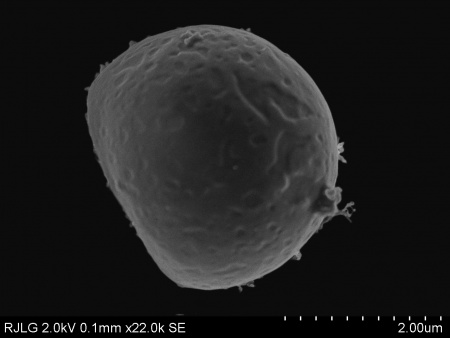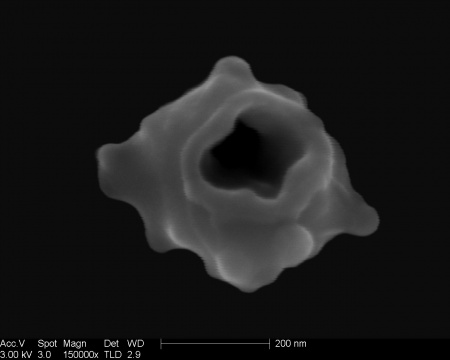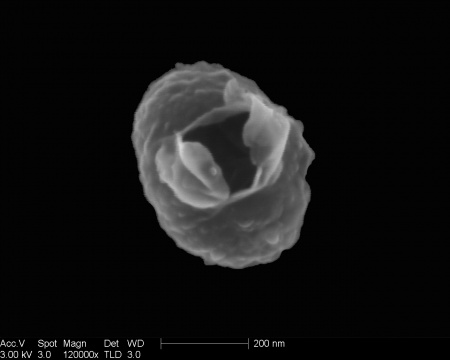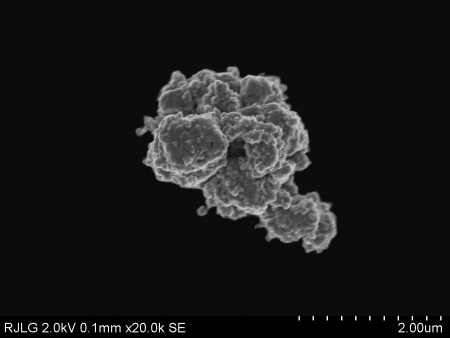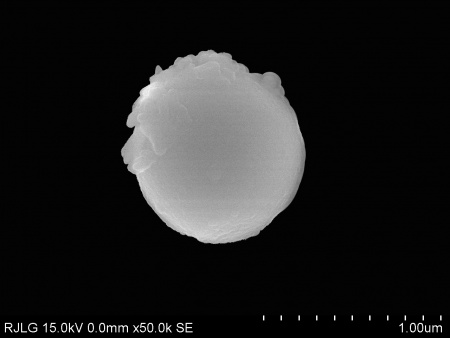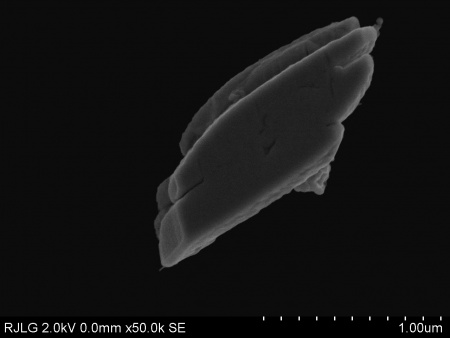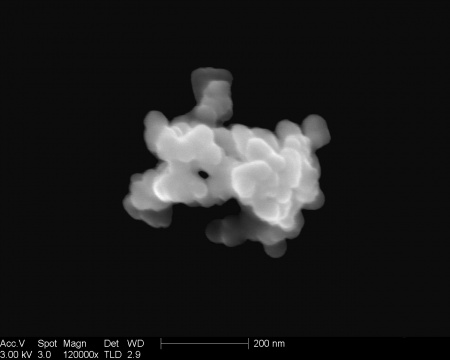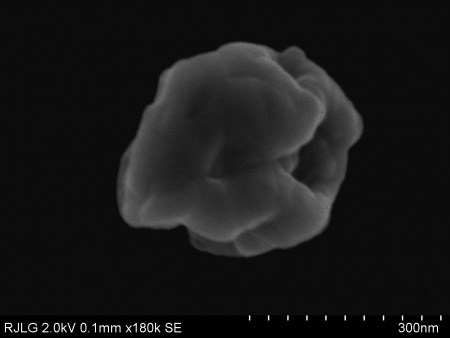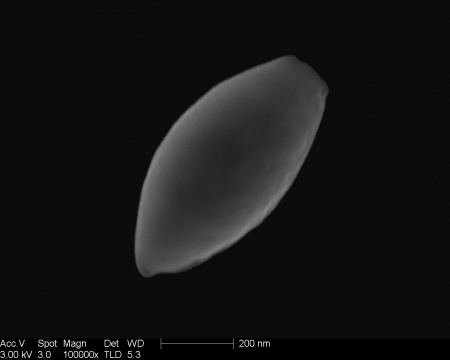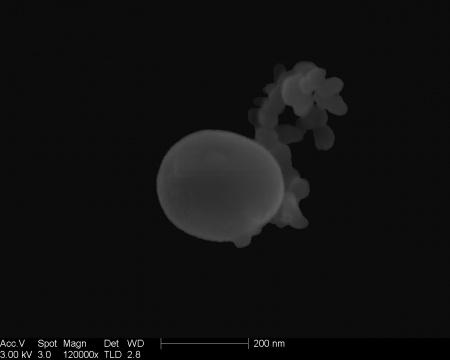DAURE Microscopy: Difference between revisions
| Line 134: | Line 134: | ||
|-style="height:140px" | |-style="height:140px" | ||
| align="center" bgcolor="lightgrey"| [[image:BCN03_18_Sulfate.jpg|450px]] || '''Particle BCN-17''' <br>Sulfate <br> | | align="center" bgcolor="lightgrey"| [[image:BCN03_18_Sulfate.jpg|450px]] || '''Particle BCN-17''' <br>Subgroup: Sulfate <br> Sampling time: 02/26/09, 11-12 am <br> Size = 510 nm <br> ''Composition:'' Major components: S, O <br> | ||
---- | ---- | ||
Notes: <br>Probably ammonium sulfate or bisulfate <br> | Notes: <br>Probably ammonium sulfate or bisulfate <br> | ||
|-style="height:140px" | |-style="height:140px" | ||
| align="center" bgcolor="lightgrey"| [[image:BCN02_1_Sulfate.jpg|450px]] || '''Particle BCN-18''' <br>Sulfate <br> | | align="center" bgcolor="lightgrey"| [[image:BCN02_1_Sulfate.jpg|450px]] || '''Particle BCN-18''' <br>Subgroup: Sulfate <br> Sampling time: 02/26/09, 7-7.50 am <br> Size = 215 nm (360 nm, sulfate + soot-like)<br> ''Composition:'' Major components: S, O <br> | ||
---- | ---- | ||
Notes: <br> Bubble shaped ammonium sulfate linked to a soot-like structrure typical from diesel emissions. <br> | Notes: <br> Bubble shaped ammonium sulfate linked to a soot-like structrure typical from diesel emissions. <br> | ||
Latest revision as of 11:58, 27 April 2009
This page contains electron microscopy images acquired by Esther Coz of CIEMAT/IDAEA-CSIC at RJ Lee Group, Inc. (Monroeville PA, USA).
PM2.5 samples were collected in polycarbonate filters during the DAURE-2009 winter campaign. 12 different samples were taken at different times of the day (morning, mid-day, afternoon/evening and night). Time interval in samplings varied with PM2.5 concentration level at time of collection to avoid filter saturation.
The images presented below have been acquired with two different high resolution Scanning Electron Microscopes (FEI Sirion400 and Hitachi S5500). Background has been automatically substracted from images to enhance the morphology, but no post processing has been applied on the particles after acquisition. The different relative content of each of the groups (and subgroups) presented below has been quantified in each sample and its variations at different times of the day. More than 15,000 particles have been analyzed with a fully automated SEM (PSEM 500) and the FEI Sirion400. Size, morphological descriptors, and elemental composition of each of the individual particles have been stored. These data are still under review/analysis. Any commentaries, suggestions or corrections (if any mistake is found) are welcome. Please, email esther.coz@ciemat.es.
DAURE participants are allowed to use the pictures for meetings and presentations with proper acknowledgment. Please, contact Esther Coz in case of publishing to check the image has not been already used.
Images from the BCN site
Primary Biogenic Organic Particles
Despite not being an important group in abundance, the microscopy analysis of PM2.5 samples from BCN site revealed a very rich diversity of this particle type. Several families of spores, vegetative and insect detritus and bacteria have been identified with sizes from 300 nm up to 4 µm. Some of them are frequently mixed with other anthropogenic aerosols.
Heavy Metal Oxides
Frequently found in the PM2.5 samples collected during traffic peak hours with sizes from 800 nm up to 5 µm. Some of them are frequently mixed with mineral particles. The most abundant are iron oxides (frequently linked to minor contents of titanium and zinc).
Mineral Particles
Soot-like Agglomerates
Soot-like is the most abundant particle structure for all the samples independently of the day and time of sampling. Larger percentage of "fresh" type (BCN-13) are found on samples associated to traffic peak hours, when the opposite trend (larger abundance of "aged" type, BCN-14) occurs for samples collected during the rest of the sampling times. These types of structures are generally linked to diesel emissions. However, other type of aerosols, such as certain biogenic organic compounds, can be also linked to this type of structures.
Other Carbonaceous Particles
Examples of some other carbonaceous particles (probably organic aerosols) found in the samples are presented next.
Sulfates
Images from the MSY site
Upcoming...
Acknowledgements
The electron microscopy images contained in this page have been acquired by Esther Coz of CIEMAT/IDAEA-CSIC at RJ Lee Group, Inc. facilities. Special aknowledge is given to RJ Lee Group (Monroeville PA, USA) for kindly allowing the use of their microscopies for this study.
The work has been partially funded by the following projects of the Spanish Ministry of Science and Innovation:
- GRACCIE Project, CSD2007:0067
- Acción Complementaria CGL2008- 02817-E/CLI
- Project CGL2007-64117/CLI
